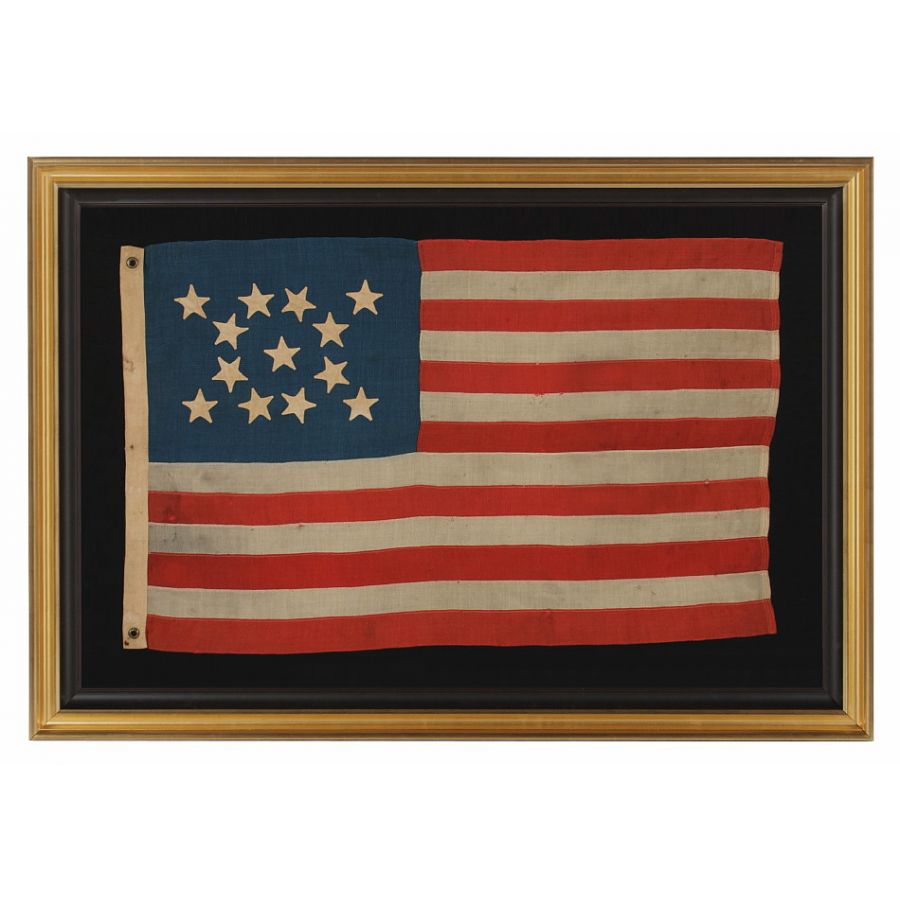
| |
13 HAND-SEWN STARS IN A MEDALLION PATTERN ON A SMALL SCALE FLAG OF THE 1876 CENTENNIAL ERA, WITH A PRUSSIAN BLUE CANTON AND AN ATTRACTIVE PRESENTATION |
|
| Available: |
Sold |
| Frame Size (H x L): |
41.25" x 59.5" |
| Flag Size (H x L): |
30" x 47" |
|
| Description....: |
|
13 HAND-SEWN STARS IN A MEDALLION PATTERN ON A SMALL SCALE FLAG OF THE 1876 CENTENNIAL ERA, WITH A PRUSSIAN BLUE CANTON AND AN ATTRACTIVE PRESENTATION:
13 star American national flag, made around the time of the 1876 centennial of American independence. The stars are arranged in a medallion pattern that features a star in the very center, surrounded by a wreath of 8 stars, with a star in each corner. This design emerged during the Civil War and became very popular afterwards, especially on printed parade flags made for centennial celebrations. Prior to the 1890's, however, it is seldom encountered on 13 star flags with pieced-and-sewn construction, such as this example.
Why 13 Stars?
The U.S. Navy used 13 stars on ensigns made for small boats, because they wished the stars to be easily discerned at a distance. This was the original number of stars on the American flag, representing the number of original colonies. As the number of stars grew with the addition of new states, two circumstances occurred. One, it became more and more difficult to fit stars on a small flag and two, it became more difficult to view them from afar as individual objects.
When small flags were produced, commercial makers often applied the same logic as the Navy, selecting the 13 star count, rather than the full complement of stars, for the sake of ease and visibility. Any American national flag that has previously been official, remains so today according to the flag acts, so 13 star flags were, and still are, official flags of the United States.
13 star flags have been used throughout our nation's history for a variety of purposes. In addition to their use by the Navy and commercial makers on small scale flags, they were produced for patriotic events, such as the annual observance of Independence Day, flown by politicians when campaigning for office, and hoisted on private ships. The Navy's use of the 13 star count on small boats officially ended in 1916 following an executive order of President Woodrow Wilson.
Since there was no official star configuration until the 20th century (1912 specifically), the stars on 13 star flag may appear in any one of a host of configurations, some of which are more interesting than others. The medallion pattern on this particular flag is desirable because of its beautiful visual presentation. This is complemented by the Prussian blue color of the canton, which is both attractive and unusual.
The small scale of the flag itself is very desirable among known examples that pre-date the 1890s. Prior to the last decade of the 19th century, most flags made for extended outdoor use were very large. Those with pieced-and-sewn construction were generally eight feet long and larger. This is because flags needed to be seen from a distance to be effective in their purpose as signals. Today their use is more often decorative and the general display of patriotism. Smaller flags exist in the early periods, but they are the exception. A six-foot example is small among flags of those that pre-date 1890, and they smaller they are, the rarer they are. Measuring just shy of four feet on the fly, this one is particularly so. Because 19th century sewn flags can be cumbersome to frame and display in an indoor setting, many collectors prefer small examples, like this one.
Due to a combination of the small scale of the flag, its hand-sewn stars, and the attractive visual qualities of both its star design and color, this is an excellent example among 13 star flags of the late 19th century.
Construction: The stars of the flag are hand-sewn and double-appliqued, meaning that they are applied to both sides. The stripes and canton of the flag are made of wool bunting that has been pieced with treadle stitching. There is a twill cotton hoist with 2 brass grommets.
Mounting: The flag has been hand-stitched to 100% natural fabrics on every seam and throughout the star field for support. The flag was then hand-stitched to a background of 100% cotton, black in color, which was washed to remove excess dye. An acid-free agent was added to the wash to further set the dye, and the fabric was heat-treated for the same purpose. The mount was then placed in a gilded French molding with excellent color and a traditional Federal period profile, to which a nearly black liner was added. The glazing is U.V. protective acrylic.
Condition: The condition is excellent for a wool flag of the period. There is only the most minor amount of mothing, accompanied by very minor staining. |
|
|
|
| Collector Level: |
Advanced Collectors and the Person with Everything |
|
| Flag Type: |
Sewn flag |
|
| Star Count: |
13 |
|
| Earliest Date of Origin: |
1870 |
|
| Latest Date of Origin: |
1880 |
|
| State/Affiliation: |
13 Original Colonies |
|
| War Association: |
1866-1890 Indian Wars |
|
| Price: |
SOLD |
|
| |
Views: 2855 |
|
|
|

